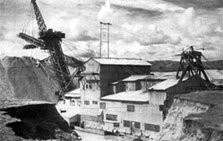The tailings on this walk are nationally significant as the only complete record of dredging activity from 1863 to 1963. They're an awe inspiring sight, hundreds of metres wide like a giant’s ploughed field.
The track entrance also links with the Alexandra-Clyde 150th Anniversary Walk.
The walks follow vehicle tracks. The surface is uneven and loose in places. Keep to the tracks.
A shorter, 30 minute return track to a viewpoint over the historic reserve starts at the carpark.
The longer walk takes in a circuit over different types and levels of dredge tailings and other relics. It follows a vehicle track for the first half hour until a line of more recent tailings is crossed. This marks the entry to the massive Alexandra Dredge, which was taken from the Clutha River/Mata Au in 1950. A short sidetrack here links with the Alexandra-Clyde 150th Anniversary Walk. An interpretive panel explains the tailings left by the different dredges that have worked in this area.
Half-an-hour beyond this is a loop walk over the tailings left by the Earnscleugh No 2 and 3 dredges. Points of interest include the original ground surface, dredge pond remnants, water races and old machinery, including dredge buckets and trommels used for sieving material.
At the end of the loop, return the way you came, or head towards the river to pick up the Alexandra - Clyde 150th Anniversary Walk again.
History and culture

The Alexandra Dredge at Earnscleugh Flat from 1940-1962
Eerie moonscape survives gold mining past.
Heritage value
By 1900 Otago’s rivers were crowded with hundreds of dredges scouring the riverbeds for gold. In the 1930s the few remaining dredges grew to immense size. They resembled giant floating factories with huge elevators dumping the residue rock high on the river flats.
The Alexandra dredge, which worked the Earnscleugh Flat until 1962, weighed 1000 tonnes and produced the sea of tailings seen today. The sequence of tailings in the Earnscleugh historic reserve is the only surviving set that tells the story of gold dredging from the 1860s to 1960s.

